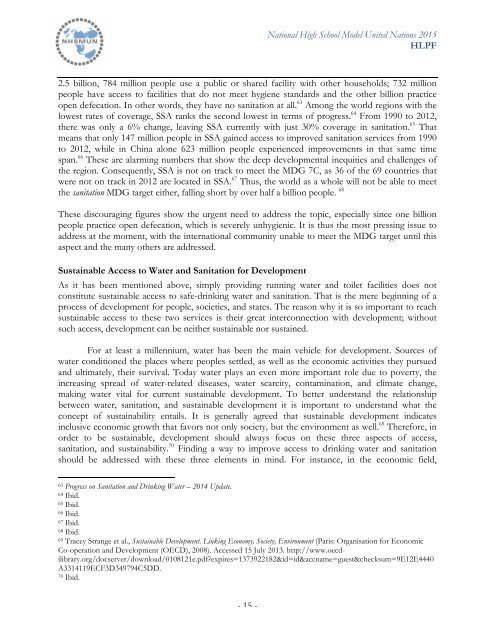d5MrHv
d5MrHv
d5MrHv
You also want an ePaper? Increase the reach of your titles
YUMPU automatically turns print PDFs into web optimized ePapers that Google loves.
National High School Model United Nations 2015<br />
HLPF<br />
2.5 billion, 784 million people use a public or shared facility with other households; 732 million<br />
people have access to facilities that do not meet hygiene standards and the other billion practice<br />
open defecation. In other words, they have no sanitation at all. 63 Among the world regions with the<br />
lowest rates of coverage, SSA ranks the second lowest in terms of progress. 64 From 1990 to 2012,<br />
there was only a 6% change, leaving SSA currently with just 30% coverage in sanitation. 65 That<br />
means that only 147 million people in SSA gained access to improved sanitation services from 1990<br />
to 2012, while in China alone 623 million people experienced improvements in that same time<br />
span. 66 These are alarming numbers that show the deep developmental inequities and challenges of<br />
the region. Consequently, SSA is not on track to meet the MDG 7C, as 36 of the 69 countries that<br />
were not on track in 2012 are located in SSA. 67 Thus, the world as a whole will not be able to meet<br />
the sanitation MDG target either, falling short by over half a billion people. 68<br />
These discouraging figures show the urgent need to address the topic, especially since one billion<br />
people practice open defecation, which is severely unhygienic. It is thus the most pressing issue to<br />
address at the moment, with the international community unable to meet the MDG target until this<br />
aspect and the many others are addressed.<br />
Sustainable Access to Water and Sanitation for Development<br />
As it has been mentioned above, simply providing running water and toilet facilities does not<br />
constitute sustainable access to safe-drinking water and sanitation. That is the mere beginning of a<br />
process of development for people, societies, and states. The reason why it is so important to reach<br />
sustainable access to these two services is their great interconnection with development; without<br />
such access, development can be neither sustainable nor sustained.<br />
For at least a millennium, water has been the main vehicle for development. Sources of<br />
water conditioned the places where peoples settled, as well as the economic activities they pursued<br />
and ultimately, their survival. Today water plays an even more important role due to poverty, the<br />
increasing spread of water-related diseases, water scarcity, contamination, and climate change,<br />
making water vital for current sustainable development. To better understand the relationship<br />
between water, sanitation, and sustainable development it is important to understand what the<br />
concept of sustainability entails. It is generally agreed that sustainable development indicates<br />
inclusive economic growth that favors not only society, but the environment as well. 69 Therefore, in<br />
order to be sustainable, development should always focus on these three aspects of access,<br />
sanitation, and sustainability. 70 Finding a way to improve access to drinking water and sanitation<br />
should be addressed with these three elements in mind. For instance, in the economic field,<br />
!!!!!!!!!!!!!!!!!!!!!!!!!!!!!!!!!!!!!!!!!!!!!!!!!!!!!!!!!!!!<br />
63 Progress on Sanitation and Drinking Water – 2014 Update.<br />
64 Ibid.<br />
65 Ibid.<br />
66 Ibid.<br />
67 Ibid.<br />
68 Ibid.<br />
69 Tracey Strange et al., Sustainable Development. Linking Economy, Society, Environment (Paris: Organisation for Economic<br />
Co-operation and Development (OECD), 2008). Accessed 15 July 2013. http://www.oecdilibrary.org/docserver/download/0108121e.pdf?expires=1373922182&id=id&accname=guest&checksum=9E12E4440<br />
A3314119ECF3D349794C5DD.<br />
70 Ibid.<br />
- 15 -


